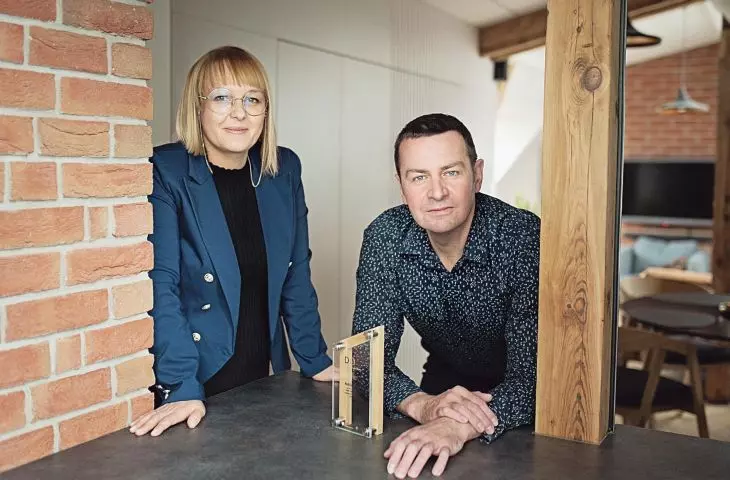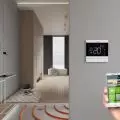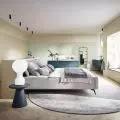Everything you want to know about passive construction
On how to achieve a passive building, reduce energy bills, heat interiors for free, and at the same time maintain the value of the building over time, we talk to the duo from the Poznan studio Pasywny M2 - Agnieszka Figielek, a designer of zero-emission buildings, and Bartosz Królczyk, an expert on zero-emission construction from the European Commission.
Ola Kloc: Let's start from the beginning - what is passive construction? How do you achieve a passive building?
Agnieszka Figielek: A passive building is otherwise known as a super-energy-efficient building. Designing such buildings, in fact, comes down to using two strategies. The first is to design the building to reduce as much as possible the loss of heat - in winter and cold - in summer. The second strategy is to make the building extract as much free heat as possible, from the sun.
Bartosz Królczyk: It can be said perversely that passive buildings are not energy-efficient buildings, because in them you don't need to save energy - they are designed and built to be full of energy! There is so much energy in them that more is not needed! The term "energy-efficient building" is often associated by investors with something negative, meaning that they have to change something in their lives so that the building generates less costs - for example, reduce the temperature in the rooms or don't open the windows. Passive building is the reverse of this scheme - we reduce the energy demand of the building itself, but by doing so we have plenty of energy to live normally in it.
Photogenic House, Poznan
© Passive M2
Ola: How do you achieve this?
Bartosz: Just as Agnieszka said - first of all by reducing the energy losses of the building. We have two main sources of losses - by penetration, no matter what material we make the building envelope out of, heat will always penetrate through it. This type of loss can be reduced in several ways. First, by limiting the size of the partitions, that is, design the building so that it has as few external partitions as possible - the body should be compact. Secondly, it is worth ensuring that the building is as small as possible, so as not to unnecessarily oversize it, then it will also have a smaller surface area of the external partitions, and therefore lower losses, and consequently energy bills will be lower. And the third way - we should insulate all the external partitions of the building, that is, the foundation slab, walls, roof, properly.
The second type of losses are losses through so-called uncontrolled ventilation - this is air that we heat in winter and cool in summer, which escapes through various types of leaks, for example, holes, gaps, cracks, that is, places where we do not have control over the flow of air. In order to reduce this kind of loss, the building should be designed and constructed as airtight, that is, without these holes and gaps, and equipped with mechanical ventilation. Not gravity, but mechanical. In a building equipped with mechanical ventilation, we pump fresh air inside and expel the used air through appropriate ducts. In this way, we have full control over the air flow and can use a device called a recuperator to recover heat from the ejected air and return it to the fresh air that is pumped into the building.
Agnes: The second thing is to make the most of the sun's energy and the so-called internal heat gains, that is, the heat that is generated by the occupants and any household appliances. If we insulate the entire building properly and don't let the internal heat escape, it will stay with us.
Bartosz: Photovoltaic panels, which are becoming increasingly popular in Poland as well, convert solar energy into electricity. This is an example of active use of renewable energy. We in passive buildings use solar energy in a passive way. Simply, when designing a building, we rotate the block on the plot in such a way and place the windows in such a way that the sun's rays, which come through the windows on the south side, directly and for free heat the interior of the building.
Photogenic house, Poznan
© Passive M2
Ola: And what about in winter and when that sun is scarce?
Bartosz: It is not in winter that the sun is "not enough", but in summer "too much". In fact, heating in winter is not a challenge at all in passive buildings, because they have such low energy needs for heating that we are able to meet most of these needs passively with internal gains and energy from the sun. In the summer, on the other hand, we need to protect the building from loss of cooling and from "excess" sun, mainly through appropriate conversion solutions. Of course, it would be great if we could use the surplus energy from the sun from the summer season to heat the building in winter, when there is less sun. Unfortunately, such inter-seasonal energy storage systems either do not exist or are currently too expensive. Hence, the best strategy is to minimize energy requirements for heating the building in winter and for cooling in summer.
Ola: How does this look financially? How long does it take for the investment in a passive house to pay off?
Bartosz: I'll ask you a trick question - imagine yourself buying a house and posing the question - "Will this house pay off for me?". Is that a question you would ask?
Agnes: This is really the clue of the whole discussion about the cost of building a house - who, when deciding to put up a house, wonders when the construction will pay off for them? We have been designing houses for individual investors for 13 years, and during that time no one has asked us this. Only once did we do an analysis of optimizing the building to fit into the client's very limited budget.
Bartosz: Investors don't look at building their house, where they will live with their family for decades, as an investment that must give them some percentage return on capital. This is not stocks or bonds. In most cases, home builders look at it this way: we have specific expectations for comfort, features, rooms to fit the family's needs, and on the other hand we have a specific budget, finances we have saved, or specific credit opportunities. And now these questions are different - do I want my family to be safe, to live healthily, when I go outside, that the air is fresh, that the temperature in the building is constant, that my children can run around in thebarefoot, so that they can roll around playing on the floor, lean against the window and not feel the cold, so that all the time our family has fresh, filtered air in the house, no flies, no pollen, so that it doesn't have to be aired every morning? Are these my priorities?
Agnes: Does my child have allergies, and do I want him to breathe air polluted by everything that comes out of the neighbors' chimneys, in a building without mechanical ventilation, when I know that this involves daily inhalations during the winter season, sitting at home all the time because the child is sick.... In fact, these are the key factors influencing what standard of construction investors decide on.
Contrasting house, Pruszkow
© Passive M2
Bartosz: This is one way of answering this question. On the other hand, we also want our house to maintain its value over time, because its purchase or construction consumes huge funds of our family, collected over many years. What can be done so that its value does not diminish? And here comes the aspect of building energy performance regulations, which are becoming more restrictive almost every year. The buildings we build today, according to the current legislation, in five years will no longer meet these standards. This means that five, ten, fifteen years from now, when that investor, that family, who today decides to buy or build a house, wants to sell it, its value will drop dramatically if it does not meet future energy performance standards. A potential buyer will be comparing this house with houses built five, ten, fifteen years from now, meaning he will have to add the cost of thermal upgrading, which will entail a much higher cost than building a house with increased energy performance standards today. After time, it is much more difficult to increase energy efficiency, adding insulation, better airtightness. Once the building is standing, it is impossible to rethink it so that it is properly oriented with respect to the sides of the world, or to position the windows so that they give thermal gains. That can no longer be done, or it will be extremely difficult, that is, very expensive.
Agnieszka: But it can be done at the beginning.
Bartosz: Yes, it is much better to do it at the very beginning. This will ensure that the value of such a house will last for many years and it will meet the standards of the future. A few days ago, the European Parliament adopted a new directive on the energy performance of buildings, which says that from 2028 all newly built buildings are to be zero-emission. That is, they must be super-energy efficient, use locally produced renewable energy and have no heat sources that emit carbon dioxide - no gas boilers, stoves, pellet boilers - none of that. This shows that in just five years, all those buildings that are built according to the current WT 2021 regulations will be obsolete and in need of thermal upgrading. Their value is already reduced and will be completely low in the future.
Agnieszka: We recently did an analysis of how the WT 2021 regulations relate to the passive standard, and we were a bit surprised. When we design zero-energy buildings, we use parameters better than those imposed by the current regulations, so we don't even check the required boundary conditions, because we know we always meet them. So, as an assignment for architects in our course, we prepared such an analysis - one of our passive standard buildings, whose energy demand is 15 kWh/m²/year, we deteriorated so that it meets the requirements from the Polish regulations, that is, we lowered all the parameters according to the guidelines of WT 2021. I didn't even think that these regulations are so drastically weak! If the demand of a building, which according to the regulations is theoretically already supposed to be almost zero-energy, is 87 kWh/m²/year (in the design for the passive standard we have requirements of 15 kWh/m²/year, and we are talking about energy-efficient buildings at 40 kWh/m²/year), we still have a long way to go, including architects, to realistically design and build zero-energy houses. Because we architects are the ones who decide to what standard we design buildings for clients, not the regulations. We are the ones who sign off on these designs and authorize them, so we are the ones responsible for this quality, and we are the only ones who can change it.
Bartosz: So it turns out that buildings implemented according to WT 2021 regulations have energy requirements for heating six times higher than passive standard buildings! Although the regulations say that WT 2021 buildings should only have an energy demand three times higher, in reality, if all factors are taken into account, it's six times higher! This means much higher bills for owners.
Agnes: And it also means a much larger photovoltaic installation to be able to reach zero-carbon.
Bartosz: In order to convert our passive standard buildings to zero-carbon, we need to cover the entire roof slope from the south with photovoltaic panels. This allows us to come out with an energy balance of zero. If we were to match the WT 2021 building standards with the European Union's 2028 guidelines, we would have to use a many times larger photovoltaic installation, which means having a many times larger roof! This is impossible. The solution, then, is not to increase the installation for energy production, but to reduce the demand for heating and cooling, and to make passive use of energy from the sun. An additional benefit of this approach is to improve the comfort of living and working in such a building.
Contrasting house, Pruszkow
© Passive M2
continued conversation on next page































